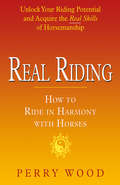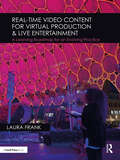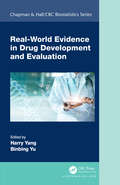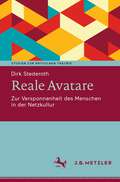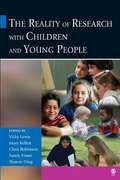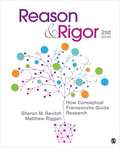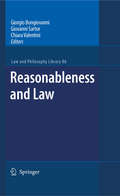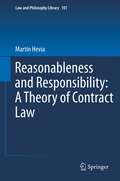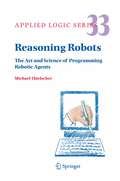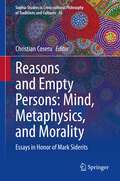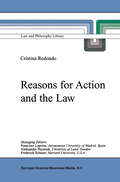- Table View
- List View
Real Riding: How to Ride in Harmony with Horses
by Perry WoodReal Riding offers exciting new ways to approach traditional and natural principles of horsemanship. The emphasis throughout is on employing empathy and understanding and looking at things from the horse's point of view. It sheds new light on common misconceptions, difficulties and contradictions, and the pages are crammed with exercises, simple 'tricks' and things to do that can make a real difference. Innovative, thought-provoking and fun, this book can be read from cover to cover or dipped into, always to find some priceless insight into an aspect of horsemanship. Perry Wood puts harmony with horses within the grasp of every rider and brings the art of riding into the twenty-first century.
Real-Time Video Content for Virtual Production & Live Entertainment: A Learning Roadmap for an Evolving Practice
by Laura FrankReal-Time Video Content for Virtual Production & Live Entertainment looks at the evolution of current software and hardware, how these tools are used, and how to plan for productions dependent on real-time content. From rock concerts to theatre, live television broadcast to film production, art installations to immersive experiences, the book outlines the various applications of real-time video content – the intersection of gaming and performance that is revolutionizing how films are made and how video content is created for screens. Rather than render out a fixed video file, new tools allow for interactive video content that responds to audience activity, camera position, and performer action in real time. Combining software renderers with environmental information, video content is generated nearly instantaneously to simulate depth, creating a new world of Virtual Production. This book provides an overview of the current software and hardware used to create real-time content while also reviewing the various external technologies the real-time content is dependent upon. Case studies from industry experts appear in each chapter to reinforce the tools described, establish industry practice, and provide insight on a complex and rapidly growing discipline. Real-Time Video Content for Virtual Production & Live Entertainment prepares students and practitioners for a future working with real-time technologies and informs current entertainment technology professionals how to rethink about their old roles using these new tools. The book includes access to a companion website featuring web-based and video resources that expand on topics covered in the text. Each chapter has a unique page that points to example material, video presentations, and professional studies on chapter topics. You can visit the companion website at rtv-book.com.
Real-Time Video Content for Virtual Production & Live Entertainment: A Learning Roadmap for an Evolving Practice
by Laura FrankReal-Time Video Content for Virtual Production & Live Entertainment looks at the evolution of current software and hardware, how these tools are used, and how to plan for productions dependent on real-time content. From rock concerts to theatre, live television broadcast to film production, art installations to immersive experiences, the book outlines the various applications of real-time video content – the intersection of gaming and performance that is revolutionizing how films are made and how video content is created for screens. Rather than render out a fixed video file, new tools allow for interactive video content that responds to audience activity, camera position, and performer action in real time. Combining software renderers with environmental information, video content is generated nearly instantaneously to simulate depth, creating a new world of Virtual Production. This book provides an overview of the current software and hardware used to create real-time content while also reviewing the various external technologies the real-time content is dependent upon. Case studies from industry experts appear in each chapter to reinforce the tools described, establish industry practice, and provide insight on a complex and rapidly growing discipline. Real-Time Video Content for Virtual Production & Live Entertainment prepares students and practitioners for a future working with real-time technologies and informs current entertainment technology professionals how to rethink about their old roles using these new tools. The book includes access to a companion website featuring web-based and video resources that expand on topics covered in the text. Each chapter has a unique page that points to example material, video presentations, and professional studies on chapter topics. You can visit the companion website at rtv-book.com.
Real-World Evidence in Drug Development and Evaluation (Chapman & Hall/CRC Biostatistics Series)
by Harry Yang Binbing YuReal-world evidence (RWE) has been at the forefront of pharmaceutical innovations. It plays an important role in transforming drug development from a process aimed at meeting regulatory expectations to an operating model that leverages data from disparate sources to aid business, regulatory, and healthcare decision making. Despite its many benefits, there is no single book systematically covering the latest development in the field.Written specifically for pharmaceutical practitioners, Real-World Evidence in Drug Development and Evaluation, presents a wide range of RWE applications throughout the lifecycle of drug product development. With contributions from experienced researchers in the pharmaceutical industry, the book discusses at length RWE opportunities, challenges, and solutions. Features Provides the first book and a single source of information on RWE in drug development Covers a broad array of topics on outcomes- and value-based RWE assessments Demonstrates proper Bayesian application and causal inference for real-world data (RWD) Presents real-world use cases to illustrate the use of advanced analytics and statistical methods to generate insights Offers a balanced discussion of practical RWE issues at hand and technical solutions suitable for practitioners with limited data science expertise
Real-World Evidence in Drug Development and Evaluation (Chapman & Hall/CRC Biostatistics Series)
by Harry Yang Binbing YuReal-world evidence (RWE) has been at the forefront of pharmaceutical innovations. It plays an important role in transforming drug development from a process aimed at meeting regulatory expectations to an operating model that leverages data from disparate sources to aid business, regulatory, and healthcare decision making. Despite its many benefits, there is no single book systematically covering the latest development in the field.Written specifically for pharmaceutical practitioners, Real-World Evidence in Drug Development and Evaluation, presents a wide range of RWE applications throughout the lifecycle of drug product development. With contributions from experienced researchers in the pharmaceutical industry, the book discusses at length RWE opportunities, challenges, and solutions. Features Provides the first book and a single source of information on RWE in drug development Covers a broad array of topics on outcomes- and value-based RWE assessments Demonstrates proper Bayesian application and causal inference for real-world data (RWD) Presents real-world use cases to illustrate the use of advanced analytics and statistical methods to generate insights Offers a balanced discussion of practical RWE issues at hand and technical solutions suitable for practitioners with limited data science expertise
Reale Avatare: Zur Versponnenheit des Menschen in der Netzkultur (Studien zur Kritischen Theorie)
by Dirk StederothDie rasanten technischen Entwicklungen der letzten Jahrzehnte erwecken den Eindruck, als sei die Menschheit im Begriff, in ein radikal neues, ein Digitalzeitalter einzutreten. In diesem Buch wird gezeigt, dass vieles daran so neu nicht ist, wie es zunächst scheint. Mit der Digitalisierung realisiert sich vielmehr ein schon in der frühen Neuzeit keimender Traum einer universellen Quantifizierung und Metrisierung – und das in allen gesellschaftlichen Bereichen: so in der Ökonomie, der Verwaltung, der Öffentlichkeit, der Bildung bis hin zur Politik.Die Frage, inwieweit sich diese universellen Quantifizierungen und Metrisierungen in das Selbstverständnis der Menschen einschreiben und diese hiermit fortschreitend zu Abbildern der digitalen Strukturen machen (reale Avatare), stellt sich das Buch ebenso, wie es Faktoren aufweist, die sich gegen eine solche digitale Eingemeindung des Menschen sperren.
Realism and Explanatory Priority (Philosophical Studies Series #71)
by J. WrightOne of the central areas of concern in late twentieth-century philosophy is the debate between Realism and anti-Realism. But the precise nature of the issues that form the focus of the debate remains controversial. In Realism and Explanatory Priority a new way of viewing the debate is developed. The primary focus is not on the notions of existence, truth or reference, but rather on independence. A notion of independence is developed using concepts derived from the theory of explanation. It is argued that this approach enables us to clarify the exact nature of the empirical evidence that would be required to establish Realism in any area. The author defends a restricted form of Realism, which he calls Nomic Structuralism. The book will be suitable for professional philosophers of language, science and metaphysics, and their graduate students.
Reality Lost: Markets of Attention, Misinformation and Manipulation
by Vincent F. Hendricks Mads VestergaardThis open access book looks at how a democracy can devolve into a post-factual state.The media is being flooded by populist narratives, fake news, conspiracy theories and make-believe. Misinformation is turning into a challenge for all of us, whether politicians, journalists, or citizens. In the age of information, attention is a prime asset and may be converted into money, power, and influence – sometimes at the cost of facts. The point is to obtain exposure on the air and in print media, and to generate traffic on social media platforms. With information in abundance and attention scarce, the competition is ever fiercer with truth all too often becoming the first victim.Reality Lost: Markets of Attention, Misinformation and Manipulation is an analysis by philosophers Vincent F. Hendricks and Mads Vestergaard of the nuts and bolts of the information market, the attention economy and media eco-system which may pave way to postfactual democracy. Here misleading narratives become the basis for political opinion formation, debate, and legislation. To curb this development and the threat it poses to democratic deliberation, political self-determination and freedom, it is necessary that we first grasp the mechanisms and structural conditions that cause it.
The Reality Of Research With Children And Young People (PDF)
by Vicky Lewis Mary Kellett Sandy Fraser Sharon Ding Chris RobinsonThe Reality of Research with Children and Young People illustrates the process of carrying out research through thirteen `research stories'. Each story includes a piece of published research, accompanied by a commentary from the author of the research explaining: · the origins of the research · how research questions were formed · factors influencing the choice of methodology and data collection techniques · problems that arose and how these were dealt with · personal reflections on the project. The research examples included in this volume have been carefully selected to demonstrate the reality of researching with children from pre-school age to late adolescence. They reflect the different traditions and variety of methods of collecting data, including interview, evaluation, ethnography, experiment, survey, case study, questionnaire, longitudinal, and standardised assessment. The Reality of Research with Children Young People provides valuable insights into the process of research for students and professionals in a range of fields including education, health, welfare, childhood and youth Studies, psychology and sociology. The book was developed to accompany The Open University Course, Research with Children and Young People (EK310).
The Really Useful Science Book: A Framework of Knowledge for Primary Teachers (The Really Useful)
by Steve Farrow Amy StrachanOffering support to both trainee and practising teachers, the fourth edition of The Really Useful Science Book is the perfect tool for those who wish to extend their subject knowledge, enhance their teaching and create lessons which link directly to the National Curriculum. The easy-to-follow framework provides comprehensive science knowledge for Key Stages 1 and 2 and is fully updated with new material to inspire stimulating and engaging science lessons. The book is divided into three sections: Biology, Chemistry and Physics. Each section integrates key scientific ideas and facts with innovative teaching methods and activity suggestions, and user-friendly language and illustrations help to explain key scientific concepts. With links to global learning, discussion of common misconceptions, and ideas for cross-curricular opportunities, each chapter connects knowledge to practice and informs creative and inspiring teaching. The Really Useful Science Book is an invaluable reference resource for all classroom teachers who wish to develop the confidence to teach enquiry-based practical science with relevance to pupils and their global community.
The Really Useful Science Book: A Framework of Knowledge for Primary Teachers (The Really Useful)
by Steve Farrow Amy StrachanOffering support to both trainee and practising teachers, the fourth edition of The Really Useful Science Book is the perfect tool for those who wish to extend their subject knowledge, enhance their teaching and create lessons which link directly to the National Curriculum. The easy-to-follow framework provides comprehensive science knowledge for Key Stages 1 and 2 and is fully updated with new material to inspire stimulating and engaging science lessons. The book is divided into three sections: Biology, Chemistry and Physics. Each section integrates key scientific ideas and facts with innovative teaching methods and activity suggestions, and user-friendly language and illustrations help to explain key scientific concepts. With links to global learning, discussion of common misconceptions, and ideas for cross-curricular opportunities, each chapter connects knowledge to practice and informs creative and inspiring teaching. The Really Useful Science Book is an invaluable reference resource for all classroom teachers who wish to develop the confidence to teach enquiry-based practical science with relevance to pupils and their global community.
The Rearguard of Subjectivity: On Legal Semiotics – Festschrift in Honour of Jan M. Broekman (Law and Visual Jurisprudence #9)
by Frank FleerackersEdmund Husserl’s ideas, informed by Kant’s Critiques, constituted a point of departure when rereading philosophical problems of subject and subjectivity. In his “Phänomenologie und Egologie” (1961/63), Jan Broekman revealed how Husserl analysed the “Split Ego” notion in Kant’s vision, which became fundamental for his phenomenology. The form and function of subjectivity were likewise positioned in psychiatry and literature, as well as in aesthetics, as Jan Broekman’s texts on ‘cubism’ demonstrated. Problems of ‘language’ unfolded in studies on topics ranging from the texts of Ezra Pound to the dialogic insights of Martin Buber, all of which were involved in the development of semiotics. Two themes accompanied these insights: the notion and later Parisian mainstream called structuralism, and the urgent need to arrive at deeper insights into the links between Marxism and phenomenology. Central language concepts also played a part: as early as 1986, Jan Broekman published on ‘semiology and medical discourse’, and in 1992 on ‘neurosemiotics’, before addressing the link between speech act and (legal as well as social) freedom in 1993. In all these works, the subject and the atmosphere of subjectivity were essential aspects. In addition to his writing, Jan Broekman gave courses on current philosophical issues, law and medicine until retiring in 1996, and in his “Intertwinements of Law and Medicine” revisited subjectivity aspects, while also offering a synthetic view.In this Festschrift in honour of Jan Broekman, the contributions address the analogue/digital dichotomy in semiotics, the multicultural self in language and semiotics, semiology and legal discourse, the legal subject and the atmosphere of subjectivity, intertwinements of law and medicine, the semiotics of law in legal education, signs in law and legal discourse, making meaning in law, and legal speech acts.
Reason And Rigor: How Conceptual Frameworks Guide Research (PDF)
by J. John Matthew Matt Riggan Sharon M. Michelle RavitchDesigned for novice as well as more experienced researchers, Reason & Rigor by Sharon M. Ravitch and Matthew Riggan presents conceptual frameworks as a mechanism for aligning literature review, research design, and methodology. The book explores the conceptual framework--defined as both a process and a product--that helps to direct and ground researchers as they work through common research challenges. Focusing on published studies on a range of topics and employing both quantitative and qualitative methods, the updated Second Edition features two new chapters and clearly communicates the processes of developing and defining conceptual frameworks.
Reason And Rigor: How Conceptual Frameworks Guide Research
by Sharon M. Michelle Ravitch J. John Matthew Matt RigganDesigned for novice as well as more experienced researchers, Reason & Rigor by Sharon M. Ravitch and Matthew Riggan presents conceptual frameworks as a mechanism for aligning literature review, research design, and methodology. The book explores the conceptual framework--defined as both a process and a product--that helps to direct and ground researchers as they work through common research challenges. Focusing on published studies on a range of topics and employing both quantitative and qualitative methods, the updated Second Edition features two new chapters and clearly communicates the processes of developing and defining conceptual frameworks.
Reason, Democracy, Society: A Treatise on the Basis of Legal Thinking (Law and Philosophy Library #25)
by Sebastián UrbinaReason, Democracy, Society deals with basic points of legal theory and philosophy of law. The main contention of the book relates to the insufficiencies of the legal positivistic approach. Some of its claims are that we must sharply separate what the law is from, what the law ought to be, and that we can know what the law is without appealing to meta-legal considerations. These and other claims are criticized. The author shows that with the legal positivistic approach we cannot know, in all cases, what the law is, if that is equated to the rules posited by the legislator. He also challenges H.L.A. Hart's and MacCormick's points of view, amongst others, about the characteristic corner stones of legal positivism. Some other issues relate to human rights, legal rationality and efficiency and ethics. This book will be of interest to philosophers concerned with law or ethics, those concerned with justice in modern society and to jurists and law students.
Reasonableness and Effectiveness in Argumentative Discourse: Fifty Contributions to the Development of Pragma-Dialectics (Argumentation Library #27)
by Frans H. van EemerenThis volume presents 50 contributions on the themes of reasonableness and effectiveness and their connections, which are central issues in argumentation theory. It discusses van Eemeren’s views on the study of argumentation; the approach to argumentation adopted in pragma-dialectics; pragma-dialectical perspectives on the dialectical and pragmatic dimensions of argumentative discourse; the notion of strategic maneuvering; the pragma-dialectical method of analyzing argumentative discourse; the treatment of fallacies as violations of rules for critical discussion; pragma-dialectical views on context, the role of logic, verbal indicators of argumentative moves and argument schemes; and the process of writing and rewriting argumentative texts. The pragma-dialectical quantitative approach to empirical research on argumentative discourse is illustrated by reporting on selected, illustrative experimental studies, as well as qualitative studies of historical cases.
Reasonableness and Law (Law and Philosophy Library #86)
by Giorgio Bongiovanni Giovanni Sartor Chiara ValentiniReasonableness is at the centre of legal debate, both in academic circles and in practice. This unique reference work adopts an interdisciplinary perspective, merging jurisprudence, legal theory, political philosophy and the different branches of law. All aspects relating to reasonableness and law are addressed by the most prominent scholars in the field. In the first part of the book, the focus is on jurisprudential analyses of the concept of reasonableness and on its moral, political and constitutional implications. In the second part, reasonableness is examined in the different fields of law like Public, Private and International Law. Here in more detail the practical consequences of reasonableness are worked out, making this work of interest to practitioners as well as legal theorists.
Reasonableness and Responsibility: A Theory of Contract Law (Law and Philosophy Library #101)
by Martín HeviaIf, as John Rawls famously suggests, justice is the first virtue of social institutions, how are we to understand the institution of contract law? This book proposes a Rawlsian theory of contract law. It argues that justice requires that we understand contract rules in terms of the idea of reasonable, terms of interaction – that is, terms that would be accepted by reasonable persons moved by a desire for a social world in which they, as free and equal, can cooperate with others on terms they accept. On that basis, the book explains the main doctrines of contract law, including those governing third parties, in both the Common Law and the Civil Law.
Reasoning Robots: The Art and Science of Programming Robotic Agents (Applied Logic Series #33)
by Michael ThielscherThe creation of intelligent robots is surely one of the most exciting and ch- lenginggoals of Arti?cial Intelligence. A robot is, ?rst of all, nothing but an inanimate machine with motors and sensors. In order to bring life to it, the machine needs to be programmed so as to make active use of its hardware c- ponents. This turns a machine into an autonomous robot. Since about the mid nineties of the past century, robot programming has made impressive progress. State-of-the-art robots are able to orient themselves and move around freely in indoor environments or negotiate di?cult outdoor terrains, they can use stereo vision to recognize objects, and they are capable of simple object manipulation with the help of arti?cial extremities. At a time where robots perform these tasks more and more reliably,weare ready to pursue the next big step, which is to turn autonomous machines into reasoning robots.Areasoning robot exhibits higher cognitive capabilities like following complex and long-term strategies, making rational decisions on a high level, drawing logical conclusions from sensor information acquired over time, devising suitable plans, and reacting sensibly in unexpected situations. All of these capabilities are characteristics of human-like intelligence and ultimately distinguish truly intelligent robots from mere autonomous machines.
Reasoning with Rules: An Essay on Legal Reasoning and Its Underlying Logic (Law and Philosophy Library #27)
by Jaap HageRule-applying legal arguments are traditionally treated as a kind of syllogism. Such a treatment overlooks the fact that legal principles and rules are not statements which describe the world, but rather means by which humans impose structure on the world. Legal rules create legal consequences, they do not describe them. This has consequences for the logic of rule- and principle-applying arguments, the most important of which may be that such arguments are defeasible. This book offers an extensive analysis of the role of rules and principles in legal reasoning, which focuses on the close relationship between rules, principles, and reasons. Moreover, it describes a logical theory which assigns a central place to the notion of reasons for and against a conclusion, and which is especially suited to deal with rules and principles.
Reasoning with Rules and Precedents: A Computational Model of Legal Analysis
by L. Karl BrantingFew areas of human expertise are so well understood that they can be completely reduced to general principles. Similarly, there are few domains in which experience is so extensive that every new problem precisely matches a previous problem whose solution is known. When neither rules nor examples are individually sufficient, problem-solving expertise depends on integrating both. This book presents a computational framework for the integration of rules and cases for analytic tasks typified by legal analysis. The book uses the framework for integrating cases and rules as a basis for a new model of legal precedents. This model explains how the theory under which a case is decided controls the case's precedential effect. The framework for integrating rules and cases is implemented in GREBE, a system for legal analysis. The book presents techniques for representing, indexing, and comparing complex cases and for converting justification structures based on rules and case into natural-language text. This book will interest researchers in artificial intelligence, particularly those involved in case-based reasoning, artificial intelligence and law, and formal models of argumentation, and to scholars in legal philosophy, jurisprudence, and analogical reasoning.
Reasons and Empty Persons: Essays in Honor of Mark Siderits (Sophia Studies in Cross-cultural Philosophy of Traditions and Cultures #36)
by Christian CoseruBest known for his groundbreaking and influential work in Buddhist philosophy, Mark Siderits is the pioneer of “fusion” or “confluence philosophy", a boldly systematic approach to doing philosophy premised on the idea that rational reconstruction of positions in one tradition in light of another can sometimes help address perennial problems and often lead to new and valuable insights. Exemplifying the many virtues of the confluence approach, this collection of essays covers all core areas of Buddhist philosophy, as well as topics and disputes in contemporary Western philosophy relevant to its study. They consider in particular the ways in which questions concerning personal identity figure in debates about agency, cognition, causality, ontological foundations, foundational truths, and moral cultivation. Most of these essays engage Siderits’ work directly, building on his pathbreaking ideas and interpretations. Many deal with issues that have become a common staple in philosophical engagements with traditions outside the West. Their variety and breadth bear testimony to the legacy of Siderits’ impact in shaping the contemporary conversation in Buddhist philosophy and its reverberations in mainstream philosophy, giving readers a clear sense of the remarkable scope of his work.
Reasons for Action and the Law (Law and Philosophy Library #43)
by M.C. RedondoA focus on reasons for action and practical reason is the perspective chosen by many contemporary legal philosophers for the analysis of some central questions of their discipline. This book offers a critical evaluation of that approach, by carefully examining the empirical, logical and normative problems hidden behind the concepts of `reason for action' and `practical reasoning'. Unlike most other works in this field, it is a meta-theoretical study which analyses and compares how different theories use the notion of reason in their reconstruction of problems concerning issues such as normativity, the acceptance of norms, or the justification of judicial decisions. This book is directed primarily to scholars specializing in legal theory and concerned with the contribution practical philosophy can make to it, but it also contains important arguments and insights for all those interested in the controversy between legal positivists and their critics, in the theory of human action or in reason-based practical theories in general.
Rebel Star: Our Quest to Solve the Great Mysteries of the Sun
by Colin StuartA fascinating and comprehensive guide to the sun – our home star – which remains the greatest mystery in the solar system, and why understanding it is pivotal to our future existence here on Earth.In 1869, a great mystery was born. As astronomers observed a total solar eclipse, for the first time they saw the faint glow of the solar corona, the sun’s outer atmosphere. Measurements of a previously unknown wavelength that made up this solar light sparked hot debate among scientists, but it was another sixty years before they discovered that this wavelength was in fact iron being burned at a staggering 3 million degrees Celsius. With the sun’s surface only 6,000 degrees, this shouldn’t be possible. What we now knew about the sun appeared to defy the laws of physics – and nature.But as well as being shrouded in intriguing mystery, the unpredictable nature of the sun’s corona poses a serious threat to our life here on earth – the destructive potential of solar storms, caused by solar material travelling out into space at around 1 million miles an hour, is huge. Remaining beyond our reach until now, a new generation of ambitious solar missions are currently travelling closer to the sun than any previous spacecraft in history. As we enter this unprecedented era of heliophysics, there has never been a better time to get to grips with the workings of our home star.
Rebirding: Rewilding Britain and its Birds (Pelagic Monographs)
by Benedict MacdonaldRebirding takes the long view of Britain’s wildlife decline, from the early taming of our landscape and its long-lost elephants and rhinos, to fenland drainage, the removal of cornerstone species such as wild cattle, horses, beavers and boar – and forward in time to the intensification of our modern landscapes and the collapse of invertebrate populations. It looks at key reasons why species are vanishing, as our landscapes become ever more tamed and less diverse, with wildlife trapped in tiny pockets of habitat. It explores how Britain has, uniquely, relied on modifying farmland, rather than restoring ecosystems, in a failing attempt to halt wildlife decline. The irony is that 94% of Britain is not built upon at all. And with more nature-loving voices than any European country, we should in fact have the best, not the most impoverished, wildlife on our continent. Especially when the rural economics of our game estates, and upland farms, are among the worst in Europe. Britain is blessed with all the space it needs for an epic wildlife recovery. The deer estates of the Scottish Highlands are twice the size of Yellowstone National Park. Snowdonia is larger than the Maasai Mara. The problem in Britain is not a lack of space. It is that our precious space is uniquely wasted – not only for wildlife, but for people’s jobs and rural futures too. Rebirding maps out how we might finally turn things around: rewilding our national parks, restoring natural ecosystems and allowing our wildlife a far richer future. In doing so, an entirely new sector of rural jobs would be created; finally bringing Britain’s dying rural landscapes and failing economies back to life.
